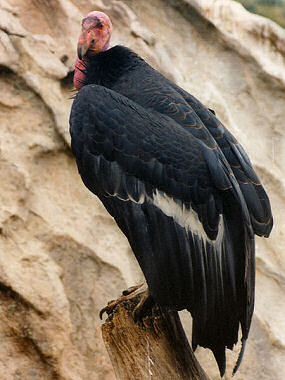California Condors are vultures and as
adults are almost entirely black in color with a few patches of white,
including distinguishing triangular patches on the underside of their
wings. Except for a few feathers, their heads and necks are mostly bare.
Their wing span can reach more than nine feet from tip to tip, which they use to soar on
wind currents and thermals. They can reach speeds of up to 55 miles per
hour (88 kilometers per hour), and they can climb to altitudes of 15,000
feet (4,600 meters). Like vultures, they are scavengers, but instead of
relying on their sense of smell they watch for other scavengers feeding
on carrion. Condors prefer large dead animals like deer, cattle, and
sheep, but they also eat rodents, rabbits, and even fish. Their bald
heads are perfectly designed to keep rotting food from sticking to them
as they eat.
reach more than nine feet from tip to tip, which they use to soar on
wind currents and thermals. They can reach speeds of up to 55 miles per
hour (88 kilometers per hour), and they can climb to altitudes of 15,000
feet (4,600 meters). Like vultures, they are scavengers, but instead of
relying on their sense of smell they watch for other scavengers feeding
on carrion. Condors prefer large dead animals like deer, cattle, and
sheep, but they also eat rodents, rabbits, and even fish. Their bald
heads are perfectly designed to keep rotting food from sticking to them
as they eat.
|
The California Condor at right
was photographed in the San Diego Zoo. |
Normally, condors breed once every two years,
producing only one egg which the female lays between January and March
on a rocky cliff (no nest is constructed for the egg). The male and
female both take turns incubating the egg. The chick hatches almost two
months later and both parents will share in feeding the chick until it
learns to find its own food, which could take a year. The birds are
capable of reaching up to 60 years of age in the wild.
California Condors are one of the most endangered
birds on the planet. In 1982, there were fewer than 25 left in the wild
due to factors including loss of habitat, shootings, pesticide residue,
lead poisoning, and collisions with power lines. Today, their numbers
have increased to approximately 200 through captive breeding. One of the
release sites for the birds is in the Vermillion Cliffs area of Arizona
near the Grand Canyon. |

